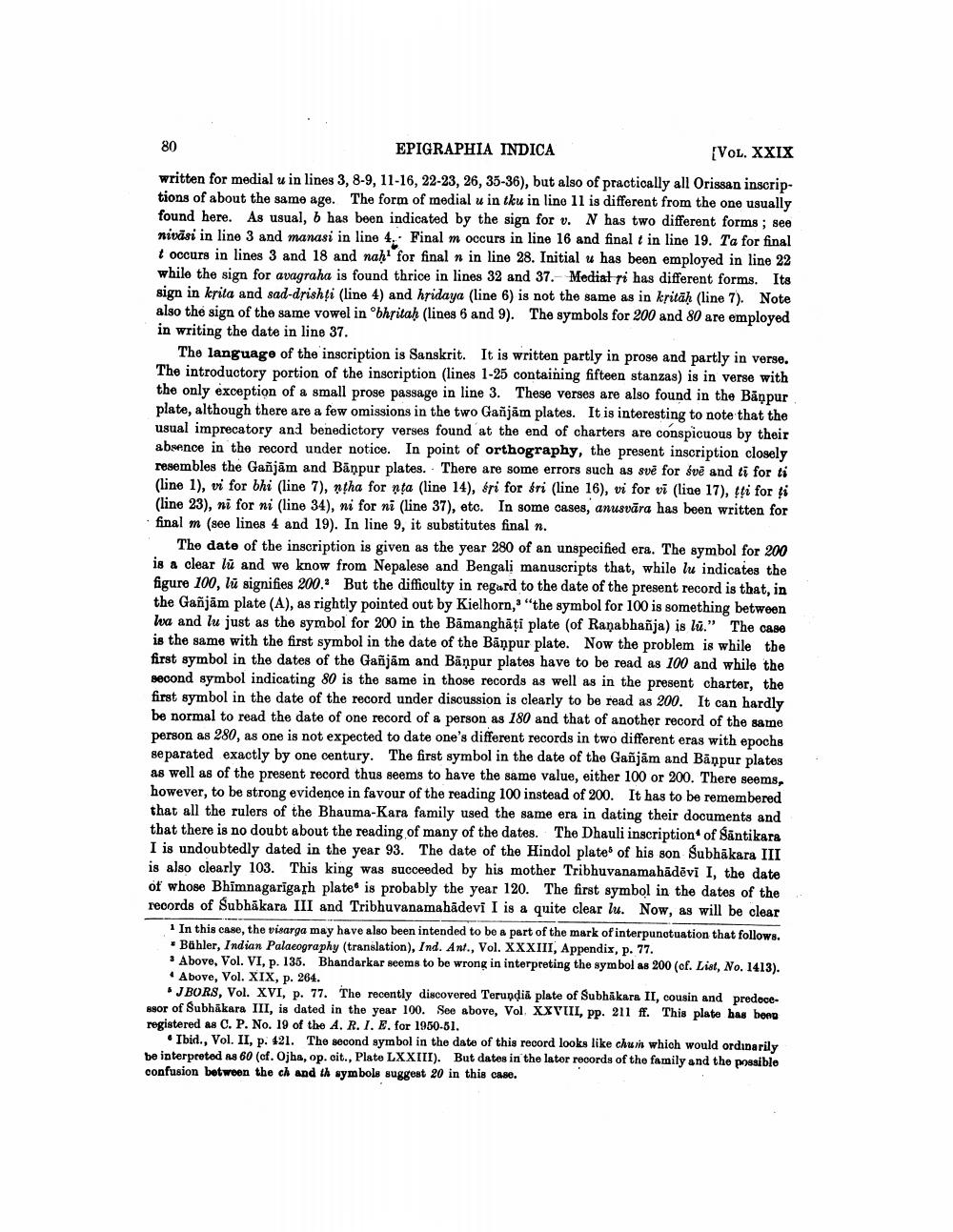________________
80 EPIGRAPHIA INDICA
[Vol. XXIX written for medial u in lines 3, 8-9, 11-16, 22-23, 26, 35-36), but also of practically all Orissan inscriptions of about the same age. The form of medial u in tku in line 11 is different from the one usually found here. As usual, b has been indicated by the sign for v. N has two different forms; see nivāsi in line 3 and manasi in line 4. Final m occurs in line 16 and final t in line 19. Ta for final t occurs in lines 3 and 18 and nahi for final n in line 28. Initial u has been employed in line 22 while the sign for avagraha is found thrice in lines 32 and 37. Mediat si has different forms. Its sign in krita and sad-drishți (line 4) and hridaya (line 6) is not the same as in kritāḥ (line 7). Note also the sign of the same vowel in obhritah (lines 6 and 9). The symbols for 200 and 80 are employed in writing the date in line 37.
The language of the inscription is Sanskrit. It is written partly in prose and partly in verse. The introductory portion of the inscription (lines 1-25 containing fifteen stanzas) is in verse with the only exception of a small prose passage in line 3. These verses are also found in the Bāņpur plate, although there are a few omissions in the two Gañjām plates. It is interesting to note that the usual imprecatory and benedictory verses found at the end of charters are conspicuous by their absence in the record under notice. In point of orthography, the present inscription closely resembles the Gañjām and Bāņpur plates. There are some errors such as svē for śve and ti for ti (line 1), vi for bhi (line 7), ntha for nța (line 14), éri for fri (line 16), vi for vi (line 17), tři for ti (line 23), ni for ni (line 34), ni for ni (line 37), etc. In some cases, anusvāra has been written for final m (see lines 4 and 19). In line 9, it substitutes final n.
The date of the inscription is given as the year 280 of an unspecified era. The symbol for 200 is a clear lů and we know from Nepalese and Bengali manuscripts that, while lu indicates the figure 100, lú signifies 200. But the difficulty in regard to the date of the present record is that, in the Gañjām plate (A), as rightly pointed out by Kielhorn,"the symbol for 100 is something between lva and lu just as the symbol for 200 in the Bāmanghāți plate (of Ranabhañja) is lū.” The case is the same with the first symbol in the date of the Bāņpur plate. Now the problem is while the first symbol in the dates of the Gañjām and Bānpur plates have to be read as 100 and while the second symbol indicating 80 is the same in those records as well as in the present charter, the first symbol in the date of the record under discussion is clearly to be read as 200. It can hardly be normal to read the date of one record of a person as 180 and that of another record of the same person as 280, as one is not expected to date one's different records in two different eras with epochs separated exactly by one century. The first symbol in the date of the Gañjām and Bāņpur plates as well as of the present record thus seems to have the same value, either 100 or 200. There seems, however, to be strong evidence in favour of the reading 100 instead of 200. It has to be remembered that all the rulers of the Bhauma-Kara family used the same era in dating their documents and that there is no doubt about the reading of many of the dates. The Dhauli inscription of Santikara I is undoubtedly dated in the year 93. The date of the Hindol plates of his son Subhākara III is also clearly 103. This king was succeeded by his mother Tribhuvanamahādēvi I, the date of whose Bhimnagarigarh plate is probably the year 120. The first symbol in the dates of the records of Subhākara III and Tribhuvanamahādevi I is a quite clear lu. Now, as will be clear
In this case, the visarga may have also been intended to be a part of the mark of interpunctuation that follows. • Bühler, Indian Palaeography (translation), Ind. Ant., Vol. XXXIII, Appendix, p. 77. * Above, Vol. VI, p. 135. Bhandarkar seems to be wrong in interpreting the symbol as 200 (cf. List, No. 1413). • Above, Vol. XIX, p. 264.
.J BORS, Vol. XVI, p. 77. The recently discovered Terupdia plate of Subhakara II, cousin and predecessor of Subhākara III, is dated in the year 100. See above, Vol XXVIII, pp. 211 ff. This plate has been registered as C. P. No. 19 of the A. R. I. E. for 1950-51.
Ibid., Vol. II, p. 421. The second symbol in the date of this record looks like chuin which would ordinarily be interpreted as 60 (cf. Ojha, op. cit., Plate LXXIII). But dates in the later records of the family and the possible confusion between the ch and th symbols suggest 20 in this case.




